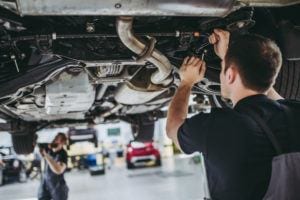 Whatever make and model of car you drive ensuring that it is safe and roadworthy is a vital part of your legal obligations and responsibilities as a UK motorist. The MOT test is an annual test that confirms just that, reviewing the safety and roadworthiness of your vehicle as well as satisfying exhaust emissions requirements.
Whatever make and model of car you drive ensuring that it is safe and roadworthy is a vital part of your legal obligations and responsibilities as a UK motorist. The MOT test is an annual test that confirms just that, reviewing the safety and roadworthiness of your vehicle as well as satisfying exhaust emissions requirements.
An MOT test is required by law for the majority of vehicles over three years of age. Any vehicles used on the road are subject to MOT testing in accordance with the Road Traffic Act 1988. As a specialist in MOT testing, we make the testing of both petrol and diesel vehicles as easy as 1, 2, 3. In addition to offering free retests from our fully equipped, state-of-the-art testing centre in Cowplain, we deliver a high quality MOT testing service every step of the way and even remind you of key vehicle dates including MOT and service due dates.
For those new to MOT testing or simply intrigued about the process, we have compiled a checklist to talk you through just what is checked on your vehicle.
The body of your vehicle
By law, the body of your vehicle and its structure must be free from excessive damage or corrosion. The sharp edges associated with severe body damage and corrosion have the potential to cause injury both inside and outside of a vehicle collision. General but essential items are also checked during the body inspection, including the condition and operation of your vehicle’s speedometer.
The Vehicle Identification Number (VIN) and registration plate will be checked as part of your MOT test. The condition and security of your vehicle’s mirrors will be checked in addition to this, whilst all lights should be operational and in optimum condition.
Your fuel system
The fuel system of your vehicle should by law be in great condition and free from damage. Fuel leaks not only affect your vehicle’s fuel economy but are extremely dangerous leaving your system susceptible to fire and explosion. During your MOT test our specialists will check for any signs of fuel leaks with a thorough inspection of your fuel pipes/hoses and wider fuel system. Your fuel cap will also be checked to ensure it is securely sealed.
Exhaust emissions and the wider system
As well as your fuel system being checked for leaks, your exhaust system will be inspected to ensure safety and security. During the exhaust system inspection, if your car was originally fitted with a catalytic converter this must be present. Emissions from your exhaust system must also meet the required standards, with carbon monoxide and hydrocarbon levels falling within the legal limit.
Your seats, seat belts and doors
All seat belts must be the correct type for your vehicle, and be secure and in good working condition. The driver’s seat should be easily adjustable and able to securely lock in the upright position. All doors must close securely, with front doors able to open from both the inside and out. The hinges and catches of all doors will be carefully checked to ensure they provide excellent security and are in great condition.
Your MOT provider will pay special attention to the boot and bonnet of your vehicle, both of which should securely latch in the closed position.
The tyres and wheels of your vehicle
Maintaining the tyres and wheels is an integral part of a vehicle’s upkeep and a primary area of inspection during the MOT process. The condition, security, size, type and tread depth will all be carefully examined to ensure they are suitable and within the legal limit.
There are many more items included on the MOT checklist, including brakes, wipers, windscreen, steering, suspension and electrics. View our full MOT checklist for further details, or learn more about our MOTs for the Waterlooville area.



